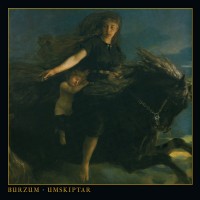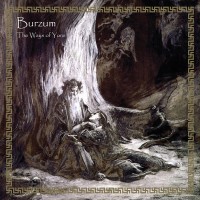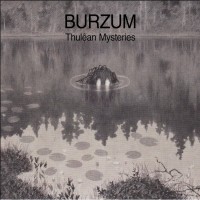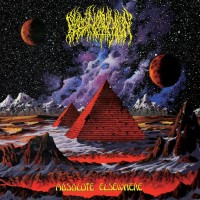Getting Into: Burzum

| Written by: | AndyMetalFreak |
| Published: | December 07, 2022 |
I think it's fair to say that no other single musician in the history of metal has been at the centre of as much controversy as the infamous Norwegian artist Varg Vikernes, and so I'm pretty sure you're all familiar with the circumstances regarding Varg's past, unless you've been living under a rock or are completely new to the whole black metal genre. Therefore, I will skip the gory details of Varg's sinister past, and guide you through what is one of the most fascinating and oddly inconsistent discographies in the world of metal.
Known for playing a vital role as bass player for Mayhem's classic debut De Mysteriis Dom Sathanas under the stage name of Count Grishnackh, Varg had also established himself a rather successful solo career, with his black metal project we obviously all now know as Burzum. The band title, meaning "darkness", is derived from the Black Speech fictional language crafted by J. R. R. Tolkien, a fitting title I must say for the dark ambient settings of his work.

1992 - Burzum




Let's begin with the self-titled debut. Back in 1992, Varg's own solo project Burzum was well under way, and so came this debut, crafted by Vikernes alongside former Mayhem guitarist Euronymous, who was back then Varg's co-producer. This was notably released in the same year as Darkthrone’s A Blaze In The Northern Sky, making it one of the first releases in what became the established 2nd wave of black metal (Norwegian black metal scene). This is the most traditional-sounding black metal release of Burzum's entire discography, and not a million miles off the sound that was produced by the majority of Norwegian black metal acts around that time, with the raw, edgy, stripped-back bare production, distorted-to-high heaven guitar tone, and deeply disturbing raspy screeches and screams for vocals.
You could perhaps also say this release contains some of Burzum's catchiest tunes, with some highly memorable riffs, especially on what I consider the highlighted tracks, "Ea, Lord Of The Deeps", "My Journey To The Stars", and "Black Spell Of Destruction". This also contains some impressively short, experimental atmospheric interludes, such as "The Crying Orc" and "Channelling The Power Of Souls Into A New God"; although perhaps a little filler, these do give you a glimpse into the synth work Burzum would provide on future releases.

1993 - Aske




Aske is Burzum's 1993 EP, and it also happens to be one of the band's most infamous releases, mainly due to it featuring one of the most iconic album covers in the history of black metal. It is a photograph of Fantoft Stave Church after its arson on the 6th of June 1992, which Varg himself was strongly suspected of having commited. With the sadistic story aside, this EP contains only three tracks, but each one certainly made an impact. It begins with "Stemmen Fra Tårnet", a simple but raw and effective track, sounding very much like something that wouldn't have been out of place on the debut. Then comes the instrumental track "Dominus Sathanas", with its eerily dark and sinister atmosphere. The EP finishes with the epic, ten-minute track "A Lost Forgotten Sad Spirit", which had also appeared on Burzum's debut in a raw demo form.

1993 - Der Som Engang Var




The year after the self-titled debut was released, Burzum presented us with Det Som Engang Var. Unlike the debut, this contained a higher use of synth work, focusing even more on creating a dark and mystical atmosphere. This release may have strayed away from the traditional raw approach of the debut, but it was where Burzum really began to develop its well-known ambient style.
This was a pretty solid and consistent album overall, despite the rushed production, and contains several tracks that are definitely worth taking note of, especially the two tracks "Key To The Gate'' and "Lost Wisdom"; each track is relatively short and catchy, both with a fantasy theme setting, and both provided memorable riffs. As usual, there are several instrumental interludes on here, which again may seem a bit like filler material to most listeners; however, "Han Som Reiste'' is a vastly different approach to the rest. It's basically a medieval dungeon synth track with a strong fantasy vibe, showing Varg's fascination with all things fantasy. Now for me, the song "En Ring Til Å Herske '' is the clear highlight; with its slow-paced build-up, and eerily cold ambience, the track is a clear forerunner of the depressive black metal genre that was soon to take shape.

1994 - Hvis Lyset Tar Oss





Hvis Lyset Tar Oss is the third release, and is definitely one of Burzum's most fascinating albums, as it could well be considered the first atmospheric black metal album of its kind. Even though only four tracks are featured here, two of those tracks are just over fourteen minutes long, with the other two not exactly being short either.
This album truly shows Burzum at its most experimental, with no track being more so than the lengthy closer "Tomhet" ("Emptiness"), which is such an interesting synth-based concept, one with a unique atmospheric journey that is neither up lifting nor depressive; it basically does as the title says, leaves you feeling emotionally empty, and almost completely helpless. The other song that is definitely worth taking note of is the lengthy opener, "Det Som En Gang Var" ("What Once Was"), which for me is one of the most impressive tracks in Burzum's entire discography; the structure has such a dynamic range of sounds, despite the melodies being repetitive throughout, and it's also very well crafted, with one of the best riffs and keyboard melodies I've heard in black metal.
A main contributor to this unique sound and style is in the lo-fi rough and simplistic production, which is exactly what gives this album its true authenticity; you can genuinely feel Varg's emotion through the songwriting and dark howling screams echoing in the background.

1996 - Filosofem





Now, if you were to have multiple polls on deciding which Burzum album was best, then there is no doubt that Filosofem would at least come out on top the majority of the time. This for me was Burzum's absolute pinnacle, and I would go as far to say it's one of the best black metal albums ever produced, especially in the ambient/atmospheric black metal category. Even though the album was released in 1996, this was actually the last Burzum album Varg recorded before his imprisonment in 1994, so I guess there's no surprise at all that it all went downhill from here on in. The song on this album are all quite long, with the shortest being just over seven minutes, and the longest being "Rundgang Um Die Transzendentale Säule Der Singularität", clocking at an impressive twenty-five minutes.
What makes this particular album special, though, is the uniquely divine sound, mostly due to the particular lo-fi production, which Varg insisted on creating. The ambient setting still to this day amazes me, and many listeners also, with the hazy soundscapes and hypnotic rhythms from the tremolo riffing, blast beats and synthesizers, which are captivating to say the least. The opening track "Dunkelheit" (originally titled "Burzum") is for me the standout track, especially for its opening melodic build-up, as well as the main riff and synth structure throughout, whereas "Jesu Død/Jesus' Tod", at over eight-and-a-half minutes, is primarily based on a single hypnotic riff, with very little variation. This may sound like a tediously repetitive concept, but there's something quite addictive about listening to it, as those hypnotic rhythms really capture you and draw you in deeper with each listen.

1997 - Dauði Baldrs


Dauði Baldrs is the first of Varg's releases for Burzum during his imprisonment. It's solely a dungeon synth-based record, and not one of his most memorable moments in all honesty, especially while following his greatest achievement, Filosofem. While in prison, Varg was unable to use instruments or recording equipment, so was limited to only a basic synthesizer and tape recorder, and thus Dauði Baldrs was his result. The album is basically a concept about the legacy of Baldr, the second son of Odin in Norse mythology, and the whole album is a lead up to Ragnarök, the battle at the end of the world in Norse mythology. The structure of the album itself is very simple, with the only real thing standing out for me being the melody on "Bálferð Baldr", which is literally the dungeon synth version of the main riff from "Jesus’ Tod" off of Filosofem.

1999 - Hliðskjálf



Swiftly moving on now to Burzum's sixth release, and his second to be recorded during his imprisonment. Much in the same case as the previous album Dauði Baldrs, Hliðskjálf was creating using only a basic synthesizer and tape recorder due to his imprisonment, in which he was only given one week to fully record the album. This album was never exactly a success due to the lack of facilities and limited time he had, although the whole ambience and synth work is a massive improvement over Dauði Baldrs, and some of the dungeon synth soundscapes would make for perfect background music in a fantasy RPG computer game.

2010 - Belus




Belus is Burzum's seventh release, after an eleven-year absence, and perhaps you could say a return to his old form following two mediocre releases. Originally to be named "The Return Of Baldur", Belus is themed around the ancient myths of the God Belus (Baldur), particularly his journey through the underworld and his return. Although a shadow of his pre-imprisonment material, Belus does contain some of the old former magic, with the structure from the synth work, tremolo riffing and hypnotic rhythms closely resembling that of Filosofem.
The album mainly consists of ambient instrumental tracks, but the hazy guitarwork is clearly present once again, and the lyrics were entirely written in Norwegian. The flow of the record itself is tremendous; however, as individual tracks it does very much lack in consistency, with only two tracks that really stand out for me. Those are "Belus Doed" ("Belus' Death"), with once again another similar melody and structure to "Jesus’ Tod" from Filosofem, and the epic atmospheric piece "Glemselens Elv" ("River Of Forgetfulness"), the longest track on the album at just shy of twelve minutes long, and clearly one of the more dynamic and melodious songs on the album.

2011 - Fallen



Fallen is the eighth release, and one that follows very much in the footsteps of Belus, with the melodies and structure of the tracks being very similar. Varg, however, did state that, although musically it takes after Belus, the sound and production style is more experimental, with the lyrics being almost back to basics, taking a more personal theme like that of the debut. So really you could say Fallen was a shot at creating something of Burzum's past whilst introducing present ideas. Sounds all fine and dandy; however, for many this did not entirely work to the effect Varg had initially intended. The production was different, sure, in the sense that it strayed away from the raw edgy sound to I guess a cleaner, more refined and classical approach, but musically the tracks fell into the trap of becoming stale and once again repetitive, and the album gave off the impression that Varg was beginning to run out of his magic.

2012 - Umskiptar



Umskiptar is the ninth release, with the title being the old Norse word for Metamorphosis. The album's lyrics are taken from the Old Norse poem Völuspá. Varg had initially described this release as going back to the traditional roots of black metal, with the lo-fi production and distorted guitar sound, referring to the style set around that of the debut, but also with a touch of Viking metal, paying homage to the likes of Viking-era Bathory and early Enslaved.
Although at first the music itself seems like a direct follow-up from Fallen, with much of the same melodies; there are a few new elements featured, the more extensive guitarwork being most noticeable, the acoustic and bass work in particular. However, the album is riddled with flaws, the first being the length, which wouldn't be so much of an issue if it didn't contain so much filler material, but this is certainly way too long. Something else that can't go unnoticed is just how few harsh vocals are present, but rather the use of spoken word instead, which does sound a little corny, and starts to get annoying over time, I have to admit. Overall, it's not one of his strongest releases, despite the effort put in, but I admit it's definitely a grower (if you have the patience level of a demonic saint, that is).

2013 - Sôl Austan, Mâni Vestan



Sôl Austan, Mâni Vestan (Old Norse for "East of the Sun, West of the Moon'') is the tenth release. Now this release is much like Dauði Baldrs and Hliðskjálf, meaning it's an instrumental synth-based album with hardly any black metal elements involved. The songs from this album were also used as the soundtrack for the film ForeBears, which was produced and directed by Vikernes and his wife.
Varg did state that this album was to be a combination of his former instrumental synth work, but with a strong influence of Tangerine Dream, which was made clear in the dreamy atmospheric soundscapes. This release is said to be one of the most disappointing in Burzum's discography, and it's not exactly hard to see why. It's very simple and minimalistic, and although there is a slight mystifying aura about the build-ups, there really isn't much more to find memorable.

2014 - The Ways Of Yore


The Ways Of Yore is the eleventh release, and retains the ambient feel and medieval music from the previous album Sôl Austan, Mâni Vestan; however, vocals are introduced on this record, which mostly consists of chanting and spoken word. The album contains several re-recorded versions from tracks off of previous albums, the first being "Emptiness", a version of "Tomhet'' from Hvis Lyset Tar Oss, as well as the track "To Hel And Back'', which is a version of "Til Hel Og Tilbake Igjen'' taken from the album Fallen.
The album has an ultra-calm ambient feel to it, with slow-building, repetitive synth structures; many synth melodies are similar-sounding to what you've heard on previous records. It seems by this stage in Varg's career he opted for meditation therapy music, rather than something metalheads would appreciate, but perhaps this is a new calmer side to Varg, as the music here is clearly mellower, with his former metal aggression being practically non-existent. Obviously, this style didn't suit everyone, especially fans of his original black metal material; the music is for most part is tedious, and if you’re not in the right mood emotionally, then it can actually be rather irritating background music.

2020 - Thulêan Mysteries


Thulêan Mysteries is Burzum's final release, and perhaps fans of his original black metal material might have been hoping for something along the lines of Filosofem; maybe his discography would end on a high after several disappointing releases, but no, instead Thulêan Mysteries is actually a double-sided album consisting of random tracks written and recorded by Varg since The Ways Of Yore: basically, leftover material. Again, this release, much like his previous records, contains re-recorded versions of tracks from past albums, the first being the track "The Loss Of Thulê", which is an alternative version of "The Crying Orc" from the debut, and also the track "Skin Traveller", another version of "Han Som Reiste" from Det Som Engang Var.
As stated by Varg himself, his true passion had never actually been music, but playing tabletop role-playing games, so Thulêan Mysteries is an album intended for the use of background music for his own MYFAROG (Mythic Fantasy Role-Playing Game), which I suppose sums up his intentions for his many ambient dungeon synth releases.
Now whether you love or loathe the guy (most understandably the latter), there is no denying the fact that Varg was one of the most important and influential figures in black metal history, as he helped kick start the notorious Norwegian black metal scene back in the early 90s. He experimented, developed and mastered a sound so unique that his music is still used as a template for black metal bands of today, and he has since become a meme for all things sinister and vile in the metal community, understandably. Through the music of his later releases, it seems the mad man had wanted to express the depths of how his emotional state had mellowed out somewhat, but most metalheads will always remember the music he brought to the metal world during the early 90s; for me, his pre-imprisonment material will stand the test of time, whether it's the music to your taste or not.
 | Written on 07.12.2022 by Feel free to share your views. |
Comments
Comments: 22
Visited by: 239 users
| Bad English Tage Westerlund |
| AndyMetalFreak A Nice Guy Contributor |
| Alakazam spendin' cheese |
| MahoDM Dumbass |
| nikarg Staff |
| AndyMetalFreak A Nice Guy Contributor |
| nikarg Staff |
| M C Vice ex-polydactyl |
| AndyMetalFreak A Nice Guy Contributor |
| AndyMetalFreak A Nice Guy Contributor |
| X-Ray Rod Skandino Staff |
| AndyMetalFreak A Nice Guy Contributor |
| Aries Rising |
| AndyMetalFreak A Nice Guy Contributor |
| Alakazam spendin' cheese |
| nikarg Staff |
| F3ynman Nocturnal Bro Contributor |
| nikarg Staff |
| Aries Rising |
| no one |
| AndyMetalFreak A Nice Guy Contributor |
| Alakazam spendin' cheese |
Hits total: 5220 | This month: 170










